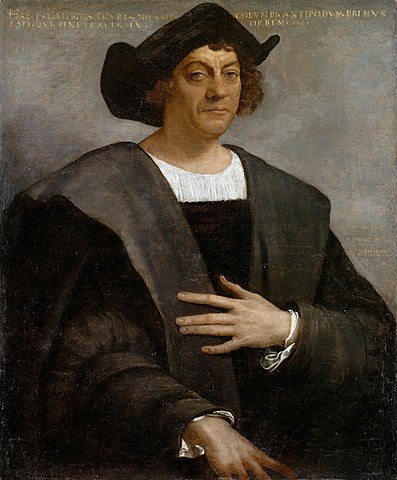
Did Christopher Columbus really think he had landed in India? Not India, but the Indies, and, yes, he did.
When Columbus said he was aiming for the Indies, he wasn’t thinking of India. He was thinking of the islands to the east of Asia, such as Indonesia, the Philippines, and New Guinea. There were no country separations then and everything was considered to be part of the Indian subcontinent. This naming can be seen in the French colony French Indochina, which was Cambodia, Laos, and part of Vietnam.
Europe had known about India, China, and Japan for over a thousand years. Since at least 1000 BC (3,000 years ago), Chinese silk was being traded into Egypt. Similar silk was found in Germany in 500 BC. When Rome conquered Egypt, the trade with China and India increased greatly. By the time of Christopher Columbus (1451 to 1506), the Mongol Empire had lost control over the route and the Ottoman Empire had taken control of Constantinople and large parts of the route. The Ottomans closed the silk road to Christian traders and people were looking for other ways to get the silks, spices, and other luxuries out of Asia. Columbus thought that he might be able to sail west and reach the Indies from the other side.
Columbus came up with his idea that you could sail west to the Indies in about 1480. He didn’t just come up with the idea, he had read about it. An astronomer called Paolo dal Pozzo Toscanelli had suggested the possibility and Columbus read his books. Columbus even wrote to him for support and Toscanelli sent him a map to use. Columbus read other books as well, but he only read books that supported his theory and ignored books that didn’t. The biggest problem was that he underestimated the circumference of the Earth and how far Asia was from Europe. He planned to set sail from the Canary Islands and he thought that it would be a journey of 4,400 km to Japan, where he could resupply before heading for China. He thought it would be a shorter distance than going all the way across land. The actual distance from the Canary Islands to Japan is 19,600 km. No ship of the 15th century could sail that far.
Columbus took his plan to King John II of Portugal. The king’s advisors calculated that Columbus was wrong and his distance was far short of the actual distance. King John rejected him. Columbus went back again in 1488, but was rejected again. He took his plan to King Ferdinand and Queen Isabella of Spain. They also rejected him because his calculations were wrong. However, in 1491, they engaged him so that he wouldn’t go elsewhere. He sailed in 1492 with promises of riches and power if he succeeded.
In October of 1492 he landed in the Bahamas and in early 1493 he explored the coast of Cuba. He called the people he met Indians because he was convinced he had landed in the east of the Indies. In 1493 he sailed for a second time, this time with enough people to establish a colony. He found what is now known as the Dominican Republic, Cuba again, and Jamaica. When he got back to Spain he claimed that he was very close to China and that there was a landmass past the islands which was probably China. He sailed for a third time in 1498 and headed further south. He passed Trinidad and landed on the coast of South America, where Venezuela is now. He realized he had landed on a continent but still thought it was the edge of Asia. He governed his new colony for a year before sailing back to Spain again. He sailed for a fourth and last time in 1502. He headed even further south because he was looking for a way to get round the landmass to India. He spent two months looking for the entrance to the Indian Ocean, which he obviously didn’t find because he was thousands of kilometers away. Columbus returned to Spain and died two years later.
From his very first voyage until his death Columbus believed that he had landed in Asia. He could not be convinced of his mistake by anybody. Phycologists have used this as an example of confirmation bias. He only listened to evidence that said he was right and ignored anything that said he was wrong. This is something we can see in our own lives thanks to the prevalence of conspiracy theories and YouTube. Columbus went to great lengths to believe he wasn’t wrong. He lied about the distance during his first voyage to his crew to explain why they had sailed further than he thought they were. He discounted the fact that the places he landed in were nothing like China and the people spoke languages that were nothing like Asian languages. When he was in Panama he learned of a large body of water on the other side of the country, but he ignored it because there couldn’t possibly be a sea if he was in Asia. Back at home, he was faced with ample evidence that the continent he had landed on was not China, but he ignored them. Amerigo Vespucci landed in Brazil in 1501 and realized he was on a new, undiscovered continent, which is why the land is named after him. Columbus didn’t believe this and was convinced he had landed in the Indies until the day that he died. And this is what I learned today.
Image By Sebastiano del Piombo – This file was donated to Wikimedia Commons as part of a project by the Metropolitan Museum of Art. See the Image and Data Resources Open Access Policy, Public Domain, https://commons.wikimedia.org/w/index.php?curid=27554267
Source
https://skeptics.stackexchange.com/questions/5271/did-christopher-columbus-believe-america-was-india
https://www.smithsonianmag.com/travel/columbus-confusion-about-the-new-world-140132422/
https://en.wikipedia.org/wiki/Christopher_Columbus
